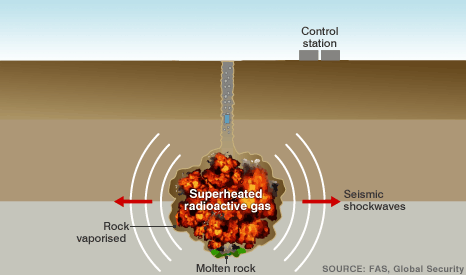Nontraditional Blowout
Prevention

Some rather strange methods have been
tested to close a blown out well. in 1966 the Soviet
Union had an uncontainable blowout on natural gas
wells. To stop the escaping methane the Soviet Union
drilled a hole 25 to 50 meters away from the blown
out well and lowered a 30 kiloton nuclear bomb
underground to 6 kilometers. Once it was in place,
they filled the whole with concrete and then ignited
the nuclear bomb. When the bomb exploded it
had enough force to create a shock wave that crushed
the pipe and closed the leaking well in 23 seconds.
After the blast a radiation survey was conducted and
the results declared no radiation activity.
Click Image to View YouTube
Video (3:48)
|
The Soviet Program for
Peaceful Uses of Nuclear Explosions
by Milo D. Nordyke 1998
|
The Physics
In an underground explosion energy is released
very quickly creating four separate zones. During
the explosion temperature and pressure increase
greatly. With such high temperature pressure rock is
melted close to the center of the explosion creating
the first zone, a melt cavity, where rock has been
vaporized. The second zone is then formed and is
called the crushed zone
where rock has been altered in integrity. The
third zone out is the cracked zone three times the size of
the melt zone creating concentric fissures which are
cracks expanding out ward. The last zone outward is
the zone of 
irreversible strain. Where the
rocks have been deformed from pressure continue on to creating a seismic wave in earths
surface. After the shock wave occurs a rebound
closes and seals the cracks. From my guess I would
suppose that the Soviet Unions nuclear explosion
closed the well somewhere between the second and
third zone.
http://news.bbc.co.uk/2/hi/asia-pacific/6033893.stm
|
|